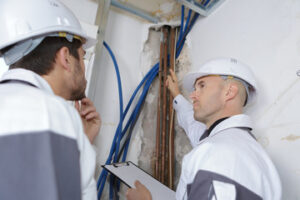Performing a plumbing inspection helps homebuyers avoid surprises after closing. The plumber will inspect the sinks, tubs, toilets, water heater, outdoor spigots, and other fixtures for signs of leaks, corrosion, or clogs.
A visual inspection can also include checking for hidden damage in crawl spaces or basements. If needed, a plumber can snake a high-definition camera into pipes and drains for a more detailed view. Click here at https://www.platinumplumbingsbc.com/ to learn more.

Leaks
Leaks can be a major problem, and they are often difficult to detect. They can cause significant damage to the home’s structure and your possessions if left unattended.
Many leaks are caused by faulty fixtures or pipes, but sometimes they can be caused by structural problems in the home. In addition to checking for leaking water, your inspector will also look for signs of water damage such as rotting woodwork or walls, mold and mildew growth, or water stains on the ceiling or wall.
Plumbing inspections are often needed when buying an older home, but even newer homes can have problems. A plumbing inspection can help you avoid costly repairs or disasters by finding potential problems before they become too serious.
A standard inspection involves a plumber looking at the home’s plumbing fixtures and appliances to check for problems like leaks, clogs, and corrosion. A visual inspection is usually enough, but for more in-depth problems you may need a camera inspection.
Your plumber will start with a visual inspection of the home’s water supply fixtures, such as sinks, tubs, showers, toilets, and outside spigots. They’ll also look at the water heater to make sure it’s working properly. Then they’ll move on to the drain lines, evaluating the material and condition of the pipes. For example, galvanized pipes are a major issue because they corrode over time and can cause water damage or even break.
Next, your plumber will check for a house trap, which is a type of pipe that creates a barrier of water underneath the drain to prevent nasty and dangerous sewer gases from entering your home. A common problem is when someone makes plumbing changes without a permit and doesn’t install the proper trap. Your plumber can also look for a “check valve” in the home’s venting system to ensure it is functioning correctly and not allowing water back up into the house from the vent. If it isn’t, your plumber will likely recommend that it be replaced. They’ll also evaluate your septic tank and drain field to make sure they are functioning correctly.
Clogs
Among plumbing problems, sewer line clogs are perhaps the most dangerous. When these lines get clogged, raw sewage can back up into sinks, showers, toilets, and other fixtures throughout the home, causing extensive and expensive damage. Thankfully, this is one problem that can often be avoided by regularly cleaning drains and avoiding putting any unnecessary waste down them (like cooking grease, fibrous vegetable peels, or paper products).
In most cases, the first sign of a sewer line issue is gurgling sounds or slow drainage issues, which may also create a foul smell. If left untreated, the clog can eventually lead to wastewater backing up into the home, which can cause significant water damage and mold growth.
Because most drainpipes are out of sight, detecting them can be difficult. Inspectors may feed a high-resolution camera into drains and other narrow spaces, which can spot broken pipes, clogs, or other issues. This can be a great way to save time and money, especially when dealing with hard-to-reach places like behind toilets and in crawl spaces.
While not as common as leaks, clogs are one of the most annoying plumbing issues. These can be caused by a variety of factors, from overflowing garbage disposals to poorly maintained drains. In some cases, a home inspector might notice a widespread clog across multiple sinks, toilets, and tubs, which could indicate that the issue is more serious than a simple drain blockage.
Another possible symptom of a clog is fluctuating toilet water levels. If a toilet’s water level is constantly going up and down, it’s likely because of a buildup of debris blocking the drain. Inspectors will check the condition of toilet float valves and flapper valves to ensure they are working properly.
In addition to checking the functionality of these components, inspectors will also look for signs of leaks around faucets, shower heads, and other fixtures. They will also test the water pressure to make sure it is at an appropriate level for the home’s usage and inspect water heaters, hose bibs, and laundry room spigots for proper function and safety.
Corrosion
Corrosion is the biggest cause of damage in plumbing systems. It happens as metal pipes react with oxygen, water, or other elements in the pipes, and can eventually lead to deterioration and failure of the pipe. If not caught early, it can result in a wide range of problems such as leaks, clogs, and reduced water flow. Detecting corrosion with regular plumbing inspections can help prevent the need for expensive repairs and replacements.
Signs of corroded pipes include bluish-green stains in sinks and tubs, rusty-tasting water, deteriorating or discolored fixtures, and poor performance from toilets and drains. Water testing can also help determine whether the corrosiveness of your water is too high and is damaging the plumbing system.
One of the most serious issues caused by corroded pipes is bursts. Often, these are the result of pinhole leaks that can grow into massive rips in your pipes over time. A plumber will be able to determine the source of the problem and repair it before it causes extensive, costly damage.
Another issue that can occur as a result of corroded pipes is corrosion under insulation (CUI). This is when the corrosion has eaten away at the interior walls of the pipe, allowing water to seep through and causing the wall to break down. Identifying this can be difficult, as the damaged areas are usually hidden behind other parts of your plumbing. However, a specialized inspection method known as real-time X-ray can quickly and easily spot the problem and alert your plumber to its location.
Regular plumbing inspections are the best way to identify any potential problems and ensure that your plumbing is working as it should be. If you notice any signs of a plumbing issue, contact us immediately to schedule a professional inspection. The sooner a problem is identified, the easier it will be to repair. The longer a problem is left untreated, the more damage it can do to your pipes and the rest of your plumbing system. The experts can provide you with a thorough plumbing inspection to find the cause of any problems and recommend solutions.
Damage
The pipes that make up a plumbing system run throughout the home, transporting gallons of water every day. Even a small leak or clog in one of these pipes can quickly cause major problems. That’s why regular inspections are important to prevent problems from happening in the first place.
A plumber can visually inspect all of the drain lines, water lines, spigots, faucets, toilets, and other fixtures in a house to look for signs of damage or corrosion. They can also test the water pressure to ensure it’s at a safe level. If they find anything wrong, they can recommend repairs or replacements.
Because most of the pipes in a building are hidden behind walls or floors, a visual inspection alone may not be enough to catch any issues. This is why many plumbing companies offer a video inspection service for a fee. This involves feeding a high-resolution camera into the drain line, sewer pipe, or other hard-to-reach spaces to spot any cracks, breaks, blockages, or other problems that may be difficult to detect with just a visual inspection.
If a plumber finds any of these issues during a plumbing inspection, they can recommend repair or replacement services right away. This will help prevent the problem from getting worse and causing more serious damage in the future. In some cases, it may be necessary to schedule a follow-up appointment to complete the work.
Another benefit of regular plumbing inspections is that they can help homeowners avoid costly damage caused by faulty or old pipes. A single broken pipe in a ceiling or wall can ruin carpeting, wood flooring, priceless artwork, and other items inside the home. These damages are expensive to fix, and they can also be dangerous for family members or visitors.
Lastly, having a regularly scheduled plumbing inspection can also help people who are planning on selling their homes. Many prospective buyers will be nervous about buying a property that has unresolved or unknown plumbing issues. A professional plumbing inspection can give sellers peace of mind that any issues will be fixed before they sell the property, which will increase the chances of a quick and easy sale.
